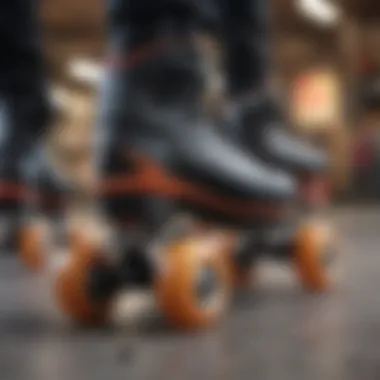Comparing the Art of Ice Skating Versus Inline Skating: A Technical Analysis


Skateboarding News Updates
Ice skating and inline skating have captured the attention of skating enthusiasts worldwide due to their technical intricacies, distinct equipment requirements, and varying popularity among skaters. Ice skating, characterized by graceful glides on frozen surfaces, presents a contrast to inline skating's smooth movements on wheels. The allure of these sports lies in their unique experiences, appealing to individuals with diverse skating preferences.
Trick Tutorials and Guides
While both ice skating and inline skating require skill and precision to master, the technical nuances set them apart. Ice skaters navigate slippery surfaces with glide and finesse, executing intricate spins and jumps with fluidity. Conversely, inline skaters maneuver on wheels, showcasing agility and speed while performing precise maneuvers and tricks. Understanding the fundamental techniques and advanced tricks of each discipline is crucial to enhancing one's proficiency and enjoyment in these sports.
Skateboarding Culture and Lifestyle
The culture surrounding ice skating and inline skating reflects a blend of athleticism, creativity, and camaraderie among skaters. From ice skating champions inspiring young talents to inline skaters pushing boundaries in street competitions, the impact of influencers on the skating community is substantial. Skateparks serve as hubs for enthusiasts to practice and socialize, fostering a vibrant community dedicated to the art of skating. Fashion trends in skating demonstrate a fusion of style and functionality, with apparel and footwear designed for performance and aesthetic appeal.
Gear Reviews and Recommendations
Equipment plays a crucial role in the performance and safety of skaters, whether on ice or wheels. Evaluating the quality of skateboard decks, trucks, wheels, and protective gear is essential for optimal performance and injury prevention. Comparative reviews of different gear options provide skaters with valuable insights into selecting the most suitable equipment for their skating style and skill level. Recommendations on gear maintenance and upgrades contribute to enhancing the overall skating experience.
Healthy Lifestyle for Skaters
Maintaining a healthy lifestyle is imperative for skaters aiming to excel in their chosen discipline. Injury prevention exercises enhance flexibility, strength, and resilience, reducing the risk of injuries during training and performances. Fitness routines tailored for skaters focus on building endurance, agility, and core strength, essential for executing advanced maneuvers with precision and control. Proper nutrition is key to sustaining energy levels and promoting muscle recovery, supporting skaters in achieving peak physical condition for optimal performance.
Introduction
In this meticulous exploration of ice skating versus inline skating, we delve into the nuanced dynamics that distinguish these two forms of skating. Understanding the technical disparities, equipment requirements, and varying levels of popularity surrounding these activities provides valuable insights into the world of skating.
Overview of Ice Skating and Inline Skating
Origins and Evolution
Analyzing the origins and evolution of ice skating reveals a rich history dating back centuries. The transition from rudimentary blade designs to modern innovations has significantly influenced the sport's current landscape. The evolution of ice skating not only showcases technological advancements but also reflects cultural shifts and societal influences. Understanding this evolution sheds light on the foundation of ice skating practices and sets the stage for comparing it to inline skating.
Global Popularity
Exploring the global popularity of ice skating and inline skating unveils contrasting trends in different regions. While ice skating thrives in colder climates with established rink cultures, inline skating gains traction in urban settings with a focus on pavement-friendly activities. The global appeal of these sports lies in their adaptability to diverse terrains and the unique experiences they offer enthusiasts worldwide. Examining the popularity of these activities provides key insights into the global sporting landscape and highlights the dynamic nature of skating trends. Bringing attention to the differing levels of popularity also sets the stage for a detailed comparative analysis in subsequent sections.


Technical Differences
Blades vs. Wheels
Construction Materials:
When examining Construction Materials in the context of ice skates and inline skate wheels, we encounter a critical aspect that defines the performance and durability of the equipment. The choice of materials, such as steel for blades or polyurethane for wheels, significantly impacts the overall functionality and lifespan of the skates. Steel blades offer unparalleled sharpness and glide on ice surfaces, ensuring precise movements and control. On the other hand, polyurethane wheels provide optimal grip and shock absorption on pavements, enhancing stability and agility during inline skating sessions.
Functionality:
The Functionality of blades and wheels plays a pivotal role in determining the performance characteristics of ice skating and inline skating. Blades are engineered to enable seamless gliding, swift turns, and efficient stops on ice rinks, emphasizing precision and speed. In contrast, wheels are designed to facilitate smooth transitions, quick maneuvers, and effective braking on various terrains, enhancing the versatility and control aspect of inline skating experiences.
Maneuverability and Control
Turning Techniques:
Mastering Turning Techniques is essential for skilled skaters to navigate through intricate movements and directional changes effortlessly. Understanding the physics of turns and implementing proper techniques can elevate the fluidity and grace of skating performances, whether on ice or pavement. By emphasizing weight distribution, edge control, and body positioning, skaters can execute sharp turns with precision and finesse, enhancing their overall control and agility.
Stopping Mechanisms:
Effective Stopping Mechanisms are critical for ensuring safety and control during high-speed skating endeavors. Whether executing a hockey stop on ice or utilizing a heel brake pad on inline skates, skaters must rely on reliable braking techniques to decelerate and halt swiftly when needed. By practicing controlled stops and enhancing muscle memory, skaters can confidently manage speed and momentum, minimizing risks of accidents and injuries.
Surface Adaptability
Ice Rinks vs. Pavements:
Comparing the performance dynamics on Ice Rinks versus Pavements uncovers the unique challenges and advantages presented by each skating environment. Ice rinks offer a smooth and frictionless surface conducive to fast glides and intricate footwork, demanding precise control and balance from skaters. In contrast, pavements present a more variable terrain with potential obstacles and rough patches, requiring adaptability and quick reflexes to maneuver effectively during inline skating sessions.
Terrain Challenges:
Navigating Terrain Challenges is a fundamental aspect of skating that tests the skills and adaptability of enthusiasts. From encountering cracks and pebbles on pavements to managing icy patches and turns on rinks, skaters must hone their awareness and technical abilities to tackle diverse terrains safely. By incorporating balance drills, agility exercises, and obstacle courses into training regimes, skaters can enhance their confidence and proficiency in handling varied skating conditions.
Equipment Variances
Skates and Protective Gear


Boot Designs:
Boot designs are a pivotal component of skates, dictating comfort, support, and maneuverability during skating activities. The architecture of the boot, including padding, ankle support, and lacing mechanisms, influences the skater's stability and control on the ice or pavement. Different boot designs cater to diverse skating styles and preferences, offering a range of features such as customizable fits, enhanced ankle support, and lightweight materials. Skaters gravitate towards specific boot designs based on their skill level, comfort requirements, and performance objectives, showcasing the crucial role of this fundamental equipment in achieving optimal skating proficiency.
Helmets and Pads:
Helmets and pads are indispensable protective gear essential for ensuring skater safety and injury prevention. Helmets shield the head from impacts and falls, minimizing the risk of head injuries during high-speed maneuvers or tricks. Pads, including knee pads, elbow pads, and wrist guards, provide crucial cushioning and protection for vulnerable joints and bones, reducing the severity of injuries in case of falls or collisions. The design and quality of helmets and pads significantly impact their effectiveness in safeguarding skaters, emphasizing the necessity of investing in durable, well-fitted protective gear for enhanced risk mitigation and confidence on the skating surface.
Specialized Tools
Ice Skate Sharpeners:
Ice skate sharpeners are specialized tools used to maintain the sharpness and edge quality of ice skates, essential for optimal performance on ice rinks. Regular sharpening of ice skates preserves blade integrity, ensuring precise turns, efficient gliding, and enhanced control during skating sessions. The intricacies of sharpening techniques, blade angles, and sharpening frequency influence the skater's agility and maneuvering capabilities on the ice, underscoring the significance of consistent skate maintenance for sustained performance excellence.
Inline Skating Bearings:
Inline skating bearings are critical components that facilitate smooth rotation of wheels, enabling seamless motion on various terrains. The quality and durability of bearings impact skater speed, stability, and maneuverability, creating distinct performance outcomes based on bearing materials, lubrication technologies, and maintenance practices. Skaters rely on high-quality bearings to optimize rolling efficiency, reduce frictional resistance, and enhance overall skating experience, underscoring the integral role of bearings in unlocking peak performance and control in inline skating activities.
Skill Development and Training
Training Techniques
Fundamental Drills
Fundamental drills represent the fundamental building blocks of any skater's development journey, offering a structured approach to mastering essential techniques and movements. These drills are meticulously designed to fine-tune balance, agility, and coordination, laying a solid foundation for skaters to progress towards more intricate skills. The key characteristic of fundamental drills lies in their ability to enhance muscle memory and cognitive skills, facilitating a smoother transition to advanced skating maneuvers. Skaters often find fundamental drills indispensable due to their effectiveness in instilling core skills while fostering a strong technical base, essential for mastering the art of ice or inline skating.
Advanced Strategies
Delving into the realm of advanced strategies unveils a realm of sophisticated techniques and tactical approaches that push skaters beyond their limits, fostering innovation and creativity on the ice or pavement. Advanced strategies encompass a spectrum of high-level skills, ranging from complex footwork sequences to strategic positioning, aimed at maximizing speed, agility, and precision in maneuver execution. The key characteristic of advanced strategies lies in their capacity to challenge skaters to push boundaries, think critically, and adapt swiftly to dynamic skating environments. Skaters often gravitate towards advanced strategies for the unparalleled thrill and sense of accomplishment they bring, propelling their skating expertise to new heights while unlocking a world of endless possibilities in the realm of ice and inline skating.
Comparative Analysis
Ice skating and inline skating are both thrilling activities that attract enthusiasts from around the world, each offering a unique experience with its technical aspects, equipment requirements, and popular appeal. The comparative analysis between these two forms of skating plays a vital role in this article by shedding light on the intricacies that differentiate them. By delving into the performance variations between ice skating and inline skating, readers can gain a deeper appreciation for the skillsets required, the challenges each activity presents, and the distinct advantages they offer.
Performance Variations


Speed and Agility
Speed and agility are essential components that significantly impact the overall experience of both ice skating and inline skating. The swiftness and nimbleness required in these activities not only test the skater's physical abilities but also add a competitive edge to the sport. Speed in skating is not merely about moving fast but also maintaining control and balance at high velocities. Agility, on the other hand, focuses on the skater's ability to maneuver swiftly and skillfully around obstacles or other skaters. These qualities are crucial in enhancing the skater's performance and overall enjoyment on the ice or pavement. Skaters who excel in speed and agility often showcase an unparalleled level of expertise and finesse, making them stand out in the skating community.
Trick Execution
Trick execution is another captivating aspect that sets ice skating and inline skating apart, adding a creative and expressive element to these activities. Mastering various tricks, spins, jumps, and flips requires not only technical proficiency but also a deep understanding of body mechanics and spatial awareness. The execution of these tricks showcases the skater's dedication, creativity, and willingness to push boundaries in pursuit of excellence. While trick execution can be visually stunning and awe-inspiring, it also poses challenges and risks that skilled skaters navigate with precision and grace. Incorporating tricks into skating routines not only elevates the performance but also offers a platform for skaters to showcase their artistry and innovation to the skating community.
Popularity and Trends
Ice skating and inline skating have gained immense popularity and continue to be trendy sports among enthusiasts worldwide. Understanding the trends and preferences in these activities is crucial for both practitioners and industry stakeholders. By delving into the dynamics of popularity and trends within the realms of ice skating and inline skating, we can grasp the evolving landscape of these sports and the factors driving their growth.
Community Engagement
Event Sponsorship
Event sponsorship plays a pivotal role in fostering the community engagement surrounding ice skating and inline skating. Sponsors provide essential financial support for events, ensuring their smooth execution and enhancing the overall experience for participants and spectators alike. A significant characteristic of event sponsorship is its ability to elevate the profile of skating competitions, attracting top talent and increasing audience engagement. While event sponsorship brings valuable resources to the table, it also introduces complexities such as balancing commercial interests with the essence of the sport. Navigating these challenges effectively contributes to the sustainability and vibrancy of the skating community.
Social Media Impact
In today's digital age, social media exerts a profound impact on the popularity and visibility of ice skating and inline skating. Platforms like Instagram, Facebook, and YouTube enable skaters to showcase their skills, connect with fellow enthusiasts, and amplify their reach to a global audience. The key characteristic of social media impact lies in its immediacy and virality, allowing content to go viral within moments and garner widespread attention. Leveraging social media offers skaters unparalleled opportunities to build personal brands, attract sponsors, and cultivate dedicated followings. However, managing social media presence also comes with challenges such as maintaining authenticity amidst commercial pressures and ensuring ethical practices in content creation. Striking a balance between publicity and sincerity is paramount for skaters looking to harness the full potential of social media in advancing their skating endeavors.
This detailed exploration of community engagement, including event sponsorship and social media impact, illuminates the multifaceted nature of building and sustaining interest in ice skating and inline skating. As these sports continue to evolve, understanding the dynamics of community involvement and digital presence becomes increasingly vital for enthusiasts, professionals, and industry stakeholders alike.
Conclusion
Ice skating and inline skating stand out as diverse and engaging forms of recreational and competitive activities. Understanding the dynamics of these two unique sports provides valuable insights into the world of skating and movement. Exploring the nuances of ice and inline skating allows enthusiasts to appreciate the technical intricacies, equipment requirements, and the distinct experiences each discipline offers. By delving into this comparison, enthusiasts can make informed choices in selecting their preferred skating style, considering factors like surface adaptability, maneuverability, and skill development. Embracing the differences between ice skating and inline skating elevates one's appreciation for the art and sport of skating, showcasing the multifaceted nature of human movement through the prism of these popular activities.
Final Thoughts
Key Takeaways
Key takeaways from this exploration of ice skating versus inline skating highlight the significance of surface adaptability and maneuverability in defining the distinct nature of each sport. Ice skating's reliance on precision blades and specialized maneuvers contrasts with the smooth functionality and terrain versatility of inline skating wheels. Understanding these differences is crucial for skaters looking to enhance their performance and enjoyment of either sport. While ice skating emphasizes graceful glides and intricate footwork, inline skating offers a more fluid and adaptable experience on various surfaces. Both disciplines, though differing in technique and equipment, share the common thread of promoting physical fitness, balance, and coordination.
With key takeaways shedding light on the essence of these sports, skaters can tailor their training methods and equipment choices to suit their preferences and goals confidently. Being cognizant of the benefits and challenges presented by ice and inline skating equips enthusiasts with the knowledge needed to navigate the intricacies of each sport effectively.
Future Prospects
Looking ahead, the future prospects for ice skating and inline skating appear promising, with advancements in technology and training methods enhancing the overall skating experience. Innovations in skate design, protective gear, and training techniques continue to push the boundaries of what is possible in these sports, offering skaters new avenues for skill development and performance enhancement. As interest in skating grows globally, so does the community of skaters who are passionate about pushing the limits of what can be achieved on ice and pavement.
The future holds exciting possibilities for both ice and inline skating, with trends indicating a steady rise in participation and spectators. Event sponsorship and social media engagement are fueling the popularity of these sports, creating opportunities for athletes to showcase their talents and inspire the next generation of skaters. By staying attuned to emerging trends and technological innovations, skaters can carve out successful careers in professional skating or simply enjoy the physical and mental benefits of these dynamic activities.







